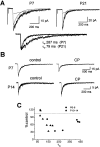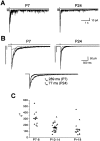Distinct synaptic and extrasynaptic NMDA receptors in developing cerebellar granule neurons
- PMID: 10594044
- PMCID: PMC6784938
- DOI: 10.1523/JNEUROSCI.19-24-10603.1999
Distinct synaptic and extrasynaptic NMDA receptors in developing cerebellar granule neurons
Abstract
In rat cerebellar granule neurons, mRNA and protein levels of the NR2A and NR2C subunits of the NMDA receptor increase during the second postnatal week. At this time, mRNA and protein levels of the NR2B subunit begin to fall. To investigate targeting of NMDA receptor subunits, we performed whole-cell recordings from rat cerebellar granule neurons at different times during development and investigated the pharmacological and biophysical properties of mossy fiber-evoked NMDA EPSCs. Isolated NMDA EPSCs from newly formed synapses in the first postnatal week exhibited partial block by the NR2B subunit-specific antagonist (1S, 2S)-1-(4-hydroxyphenyl)-2-(4-hydroxy-4-phenylpiperidino)-1-propanol (CP 101,606). By the end of the second postnatal week, NMDA EPSCs were virtually unaffected by the NR2B antagonist. In parallel, NMDA EPSC decay times decreased over a similar developmental time course. We compared properties of synaptic NMDA receptors with extrasynaptic receptors that are present on the cell body with rapid application of glutamate to excised nucleated patches. Deactivation of patch responses accelerated with development and closely resembled evoked NMDA EPSCs in rats of the same age. However, patch responses were highly sensitive to CP 101,606 through the second postnatal week, and sensitivity was seen in some neurons up to the fourth postnatal week. Spermine potentiated peak NMDA patch responses from postnatal days 10-14 rats but had little effect on evoked NMDA EPSCs. Our data suggest selective targeting of a distinct NMDA receptor subtype to synaptic receptor populations in cerebellar granule neurons. Later in development, similar changes occur in the extrasynaptic receptor population.
Figures





Similar articles
-
Developmental profile of the changing properties of NMDA receptors at cerebellar mossy fiber-granule cell synapses.J Neurosci. 2000 Aug 15;20(16):5899-905. doi: 10.1523/JNEUROSCI.20-16-05899.2000. J Neurosci. 2000. PMID: 10934236 Free PMC article.
-
Development and subunit composition of synaptic NMDA receptors in the amygdala: NR2B synapses in the adult central amygdala.J Neurosci. 2003 Jul 30;23(17):6876-83. doi: 10.1523/JNEUROSCI.23-17-06876.2003. J Neurosci. 2003. PMID: 12890782 Free PMC article.
-
The incorporation of NMDA receptors with a distinct subunit composition at nascent hippocampal synapses in vitro.J Neurosci. 1999 May 15;19(10):4180-8. doi: 10.1523/JNEUROSCI.19-10-04180.1999. J Neurosci. 1999. PMID: 10234045 Free PMC article.
-
Developmental changes in NMDA receptor glycine affinity and ifenprodil sensitivity reveal three distinct populations of NMDA receptors in individual rat cortical neurons.J Neurosci. 1998 Mar 15;18(6):1935-43. doi: 10.1523/JNEUROSCI.18-06-01935.1998. J Neurosci. 1998. PMID: 9482779 Free PMC article. Review.
-
Distribution of extrasynaptic NMDA receptors on neurons.ScientificWorldJournal. 2012;2012:267120. doi: 10.1100/2012/267120. Epub 2012 Apr 30. ScientificWorldJournal. 2012. PMID: 22654580 Free PMC article. Review.
Cited by
-
CaMKII-dependent phosphorylation of GluK5 mediates plasticity of kainate receptors.EMBO J. 2013 Feb 20;32(4):496-510. doi: 10.1038/emboj.2012.334. Epub 2013 Jan 4. EMBO J. 2013. PMID: 23288040 Free PMC article.
-
The role of the PDZ protein GIPC in regulating NMDA receptor trafficking.J Neurosci. 2007 Oct 24;27(43):11663-75. doi: 10.1523/JNEUROSCI.3252-07.2007. J Neurosci. 2007. PMID: 17959809 Free PMC article.
-
Alteration in the voltage dependence of NMDA receptor channels in rat dorsal horn neurones following peripheral inflammation.J Physiol. 2001 Nov 15;537(Pt 1):115-23. doi: 10.1111/j.1469-7793.2001.0115k.x. J Physiol. 2001. PMID: 11711566 Free PMC article.
-
Differences in GluN2B-Containing NMDA Receptors Result in Distinct Long-Term Plasticity at Ipsilateral versus Contralateral Cortico-Striatal Synapses.eNeuro. 2019 Nov 27;6(6):ENEURO.0118-19.2019. doi: 10.1523/ENEURO.0118-19.2019. Print 2019 Nov/Dec. eNeuro. 2019. PMID: 31744842 Free PMC article.
-
Altered neuron excitability and synaptic plasticity in the cerebellar granular layer of juvenile prion protein knock-out mice with impaired motor control.J Neurosci. 2008 Jul 9;28(28):7091-103. doi: 10.1523/JNEUROSCI.0409-08.2008. J Neurosci. 2008. PMID: 18614678 Free PMC article.
References
-
- Akazawa C, Shigemoto R, Bessho Y, Nakanishi S, Mizuno N. Differential expression of five N-methyl-d-aspartate receptor subunit mRNAs in the cerebellum of developing and adult rats. J Comp Neurol. 1994;347:150–160. - PubMed
-
- Arsenio Nunes ML, Sotelo C. Development of the spinocerebellar system in the postnatal rat. J Comp Neurol. 1985;237:291–306. - PubMed
-
- Chenard BL, Bordner J, Butler TW, Chambers LK, Collins MA, De Costa DL, Ducat MF, Dumont ML, Fox CB, Mena EE, Menniti FS, Nielsen J, Pagnozzi MJ, Richter KEG, Ronau RT, Shalaby IA, Stemple JZ, White WF. (1S,2S)-1-(4-hydroxyphenyl)-2-(4-hydroxy-4-phenylpiperidino)-1-pr-opanol: a potent new neuroprotectant which blocks N-methyl-d-aspartate responses. J Med Chem. 1995;38:3138–3145. - PubMed
-
- Dingledine R, Borges K, Bowie D, Traynelis SF. The glutamate receptor ion channels. Pharmacol Rev. 1999;51:7–61. - PubMed
Publication types
MeSH terms
Substances
Grants and funding
LinkOut - more resources
Full Text Sources
Medical
Miscellaneous
